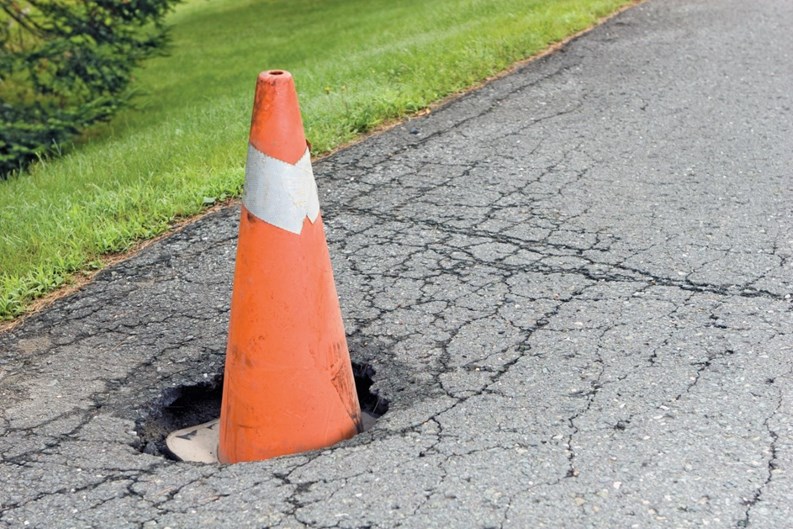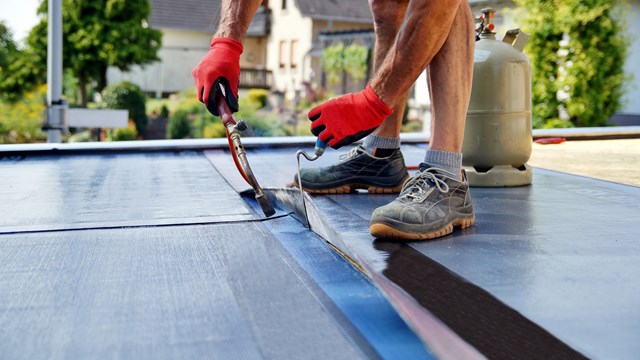Spring beckons, with the promise of all those blossoms bursting with color from early flowering bulbs. If only it were that simple. All too often, spring also beckons with fungus on the lawns, dessicated trees with branches bent and broken from heavy snow, fencing and rails bashed by snow plows, cracked potholed pavement, and clogged drainage systems.
With such a laundry list of winter damage, what should the first order of business be for HOA board members and property managers once things start to thaw? The answer to that question depends on where your association is located, what kind of damage the property may have sustained over the harsh winter months, and most importantly, what kind of liability the damage may present.
Year-Round Management
“Every site is different,” says James Rademacher of Rezkom Enterprises in Rocky Hill. “Most associations start spring cleanup projects immediately following the change in weather. Projects are scheduled in advance with each corresponding contractor. The damage caused by the winter weather is usually addressed by the on-site maintenance staff or contracted out on an emergency basis.”
A few of the main things Rademacher and other management professionals recommend that HOA managers and staff put first on their springtime to-do list includes the following:
• Inspect walks, roads, and curbs for damage caused by snow removal
• Conduct street cleaning to remove leftover sand and salt
• Inspect and repair tennis/basketball courts
• Inspect and repair playground equipment
Note necessary landscaping repairs and flower/shrub/ tree replacement
Inspect wood elements that may be in need of painting/repair/replacement.
To assess that damage, every property manager should do a walk-through of each of their properties come spring, says Gary Wilkin of Wilkin Management Group in Mahwah, and take an inventory of what needs to be cleaned up, spruced up, or repaired now that the days are warming up.
“When the sun starts to come back out, and the weather turns appropriate to walk around without sinking into knee-deep mud—usually April in our region—just look over the common areas,” says Wilkin. “Areas that are accessible by snow plows and snow blowers and so forth. There shouldn't be too many mechanical things you need to look at, since hopefully you've done all your work before the winter to prevent broken pipes and things of that nature. Get outside and look closely at all areas without the hindrance of snow cover but not until you know that you're not going to have any more snowstorms!”
“Inspections should be done late March or early April,” agrees Rademacher. “Work orders and bid requests should go out immediately. Any foreseen spring projects should go to bid in late fall or early winter.”
Many management companies keep calendars or databases that automatically notify individual property managers that it's time for this or that maintenance check-up, or property walk-through. “And as you go through the seasons,” says Wilkin, “whether it's summer issues or fall issues, or gutter cleaning, or dryer vent cleaning, we put it in our calendar to remind all of our staff members that these are things we need to discuss with our clients.”
Drain Pains
According to industry professionals, one item that should be of immediate concern to HOAs come springtime are drainage problems, which can lead to flooding and property damage. Any board member or manager who has experienced drainage problems on their property knows the importance of performing annual maintenance checks on irrigation systems, drainage basins, and even gutters and downspouts attached to buildings themselves. “Before you see the problem is always the best time to do it,” says Paul De Nora of Advanced Plumbing & Drain Cleaning, Inc. in West Paterson. “We recommend that once a year everything be cleaned and checked to avoid issues later on.”
According to Gaetano Virone of Environmental Designers Irrigation, Inc. in Howell, it's not going overboard to look at each individual sprinkler in an HOA's irrigation system during an annual or biannual check. “It’s a diagnostic check,” he says. “We can hedge ourselves on anything broken before it becomes a crisis. We can save them money before homeowners even know there is a problem. One way or another we are going to fix it and, relatively speaking, a routine check costs a lot less than a service call.”
Rain gutters and downspouts may not seem like key items on a maintenance checklist, but gutters and drains clogged and backed-up with rotten leaves and accumulated winter crud can contribute to leaks and expensive water damage, so spring maintenance is as vital here as the more conspicuous water management apparatus. “Most communities clean their gutters at least once a year,” adds Wilkin, “usually after the leaf fall. But we have many clients that want it done a couple of times a year, including right after the seedlings drop off—usually late May or early June. Sometimes after the winter you might have a gutter that pulled off because of an ice load. You look at all that when you walk around, and make a list and get those things repaired.”
Potholes and Cracks
“Certainly in this region, another thing we should do is look at any pavement damage from snowplowing and/or frost heave,” says Wilkin. “Winter damage can consist of plow damage to Belgian block curbing; turf damage where turf gets peeled back by snowplows; if you've had some deep freezes, you get heaving in sidewalks and paved areas when it finally thaws, and that may cause some cracking.”
That buckled, cracked, and uneven pavement poses safety risks if not addressed quickly. A lot of communities wait too long before calling a contractor, says Thomas J. Eosso of Eosso Brothers Paving, Inc., in Matawan. "The pavement is often in poor condition and it is too late to apply a sealer because the texture is too rough.”
Fred Haelig of paving company Halecon in Bridgewater also advises HOA managers to inspect their parking areas after the thaw. “Walk the parking lot and look,” he says. “Cracks will be visible to the naked eye.” If repair is necessary, Haelig says, “The structural cracks are cleaned out and filled out with a rubberized crack filler. Normally the potholes or the heaved areas need to be dug out and replaced with probably a stone base, a stabilized base, and surface coarse.”
Eosso advises advance planning when it comes to pavement maintenance. “Most contractors are completely booked by September [for the following spring],” he warns. “So it's important to start in the cold months and get on their busy work schedule as soon as possible.”
Landscaping Lessons
Cold weather is also tough on an HOA's landscaping elements—trees, shrubs, and the like. “The association’s buildings and grounds committee, management, and the landscape contractor generally conduct a site inspection in the spring,” says Rademacher. “At this time, they determine what areas were damaged and schedule the necessary repairs. On-going tree/shrub replacement projects can be worked on, and spring flower plantings completed.”
“In late April/early May, you can start to see growth,” says Wilkin. “Greenery starts to come into play with some of the shrubs, and then you can take a look at what you're dealing with as far as any special needs for replacements. You can also look at turf damage from either salt or snow plows.”
According to Doug Wood of The Brickman Group in Bound Brook, the bulk of landscape resuscitation occurs in the first couple of months of spring. "We will come in after the threat of any more snow accumulation and do a spring cleanup of the community, which usually includes removing any sticks and branches and leaf and garbage buildup that has accumulated over the winter," he says. "Once that's completed, we start addressing the needs of the beds." Wood also explains that this pre-work on the beds, as well as application of a fertilizer, are done before the focus moves to mowing, turf applications and seasonal color.
Spring is also the time to protect the lawn against crabgrass and insects, even before they rear their ugly heads. "Due to the excessive crabgrass problem over the last several years, we have altered our program from one application in April to a split application," Wood continues. "One prior to mid-April and following up with another in May. Not only does this method provide better crabgrass control, but we can kill three birds with one stone by including broadleaf weed control and fertilizer to the second application. The spring is a great time to control or prevent insect damage on plant material and turf areas. An application of dormant oil is a great way to reduce the amount of damage you may get to the ornamental plants in the landscape and reduced the amount of pesticides that need to be sprayed throughout the season."
Landscaping pros also point out that the effects of winter damage can be lessened by mulching around the base of smaller plants—especially evergreens and, if the location is susceptible to strong winter winds, a protective barrier can be installed around the plant. Proper pruning and the installation of support cables between limbs that may be prone to breaking under snow and ice can also help minimize damage.
Landscaping represents too much of an investment for most HOAs to just let anybody with a ladder and a pair of pruning shears have at it—so it should go without saying that for any type of landscaping work, it's essential to work with certified or licensed professional.
Other Considerations
Another landscape-related issue is playground and recreational equipment. “A physical inspection of all equipment is necessary,” says Rademacher. “Damaged parts should be replaced only with parts approved by the manufacturer. All nuts, bolts, and adjustable hardware should be inspected, tightened, and/or replaced. Wooden structures may need cleaning and sealing as well.
Swimming pools will also need attention as the busy season approaches.”
Between the pool company and the maintenance staff, the following items need to be addressed, says Rademacher:
• The pool, filtration system, and equipment must be professionally inspected
• Pool and equipment must be made operational
• Chemicals and materials for the season must be ordered
• Pool furniture, signage, and safety equipment must be cleaned and set up
• Winterized plumbing must be restored
• Bathrooms must be cleaned and stocked
• Bonding, grounding and periodic health inspections must be scheduled
HOAs make huge investments in their landscaping, infrastructure, and common amenities every year to keep it all functional, attractive, and enjoyable for residents. Each year, all these elements are challenged by tough temperatures and winter weather. By adopting and sticking to a well-thought-out inspection and maintenance plan, your association can stay on top of what needs to be done, and when—and may even save itself some money in the short and long term.
Marie N. Auger is a Massachusetts-based freelance writer and a frequent contributor to The New Jersey Cooperator.







Leave a Comment